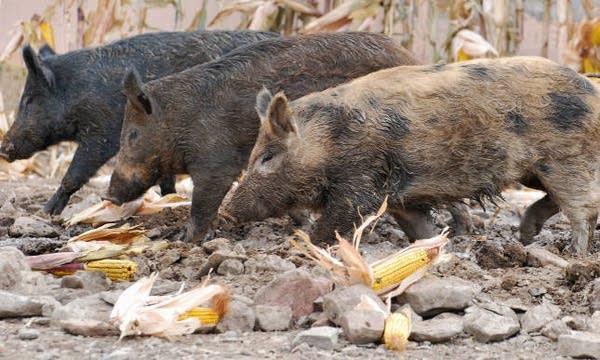Minnesota officials ready for potential feral pig invasion

Go Deeper.
Create an account or log in to save stories.
Like this?
Thanks for liking this story! We have added it to a list of your favorite stories.
In 2016, a group of domestic pigs escaped from a farm in Marshall County in far northwestern Minnesota. A sow wandered into the aspen forests and wetlands of the West Valley Wildlife Management Area, where she gave birth to several piglets. As pigs do, they began rooting with their snouts, resulting in severe rutting and other damage to the landscape.
It was a rare example of a feral pig reproducing in Minnesota, and a learning experience for state and federal wildlife officials that illustrated how quickly a population of wild hogs could get established.
“There’s an example where they could go undetected for a fair amount of time before anyone is aware of the situation, especially in more remote areas,” said Gary Nohrenberg, Minnesota director of wildlife services for the U.S. Department of Agriculture.
“So the threat is potentially real for that to happen and for a fair amount of damage to occur before anyone’s even aware of it.”
Turn Up Your Support
MPR News helps you turn down the noise and build shared understanding. Turn up your support for this public resource and keep trusted journalism accessible to all.
In that instance, USDA officials shot and killed the wild pigs. But now, at the behest of state lawmakers, several state agencies are reviewing their various roles to determine potential gaps in management to limit future damage if feral pigs were to establish a foothold in the wild.
“What happens if you are out in the wild and you’re deer hunting, and here comes a feral hog and you shoot that. Who do you call?” asked state Rep. Rick Hansen, DFL-South St. Paul, one of the legislators who asked for the review from state agencies. A report is due next February.
“Do you call the DNR? Do they dispose of it? Does the Board of Animal Health? Is it tested for swine diseases? Just what is the protocol for dealing with this?”
Serious issues
Feral swine are not native to the U.S. They were first brought to the country in the 1500s by early settlers as a source of food. Later, in the early 1900s, wild boar were introduced in some areas for hunting.
Since then, their numbers have exploded. Their population is estimated at over 6 million animals and is rapidly expanding. They’ve been reported in 35 states, including recent sightings in Wisconsin and North Dakota.
They can cause a host of serious issues to agriculture, forests and wildlife.

Their rooting and wallowing behavior “can totally uproot areas, and it impacts the vegetation,” said Leslie McInenly, wildlife populations and regulations manager for the Minnesota Department of Natural Resources.
“It also can have issues in terms of siltation and soil damage. And it can be pretty extensive. And the other issue with pigs is that they reproduce pretty quickly. And they’re smart. It’s really challenging to get rid of them.”
Feral swine compete with native wildlife for food, habitat and water. They also prey on the nests of birds that nest on the ground, and have been documented killing deer fawns and other small animals.
There are also concerns of wild pigs damaging crops and potentially spreading disease to domestic hogs. Minnesota is the second largest pork producing state in the nation.
“We want to keep our domestic population safe and and we know that preventing incursion of wild or feral swine is imperative to prevent disease from spreading in the state,” said Brian Hoefs, executive director of the Board of Animal Health and the state veterinarian for Minnesota.
‘Super pigs’
Feral pigs have long been a major nuisance across the southeastern United States, stretching from the Carolinas west to Texas. They also have established populations in California and pockets of the southwest. The closest they’ve encroached northwards towards Minnesota is to the southern reaches of Missouri.
But recently, researchers have documented an expanding population of feral hogs dubbed “super pigs” in Canada — the result of cross-breeding between domestic pigs and wild boars, that have slowly approached the U.S. border.
“They’re very adaptive to the wild nature of Canada, but they also have high reproductive rates of our domestic pigs,” said Hoefs.
“So they’ve been able to not only survive, but thrive in the Canadian wilderness. And the alarming thing is we’re seeing those populations move closer to the United States border.”

Hoefs said for a long time, people naively assumed that feral pigs weren’t a serious threat to northern states like Minnesota because of the cold climate.
“This has been a real eye opener, the feral pigs in Canada not only surviving, but thriving and expanding their territory,” Hoefs said. “So it is a big threat.”
Up to this point, feral pigs in Minnesota have all escaped from domestic farms, or been illegally released. Nohrenberg with the USDA said his office typically responds to about five to 15 reports a year.
“We don’t have the resources to have anybody actively looking for these things,” Nohrenberg said. “So we depend on reports from the public, reports from hunters, reports from law enforcement offices.”
The Minnesota DNR is also asking the public for input as state officials discuss potential changes in management of feral pigs. There is an online public meeting on Tuesday, Nov. 14 from 6:30 p.m. to 8 p.m.
State agencies are also reviewing their oversight of farmed mink. The animals are vulnerable to diseases that can also infect people, including COVID and influenza. There are about a half dozen mink farms remaining in Minnesota.



